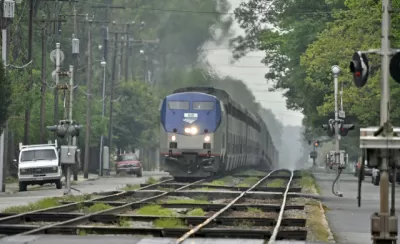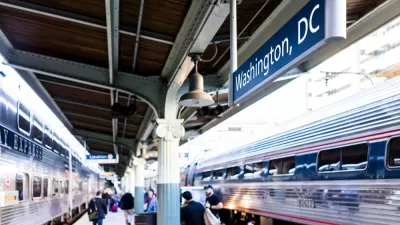The pieces of the still-speculative Southeast High Speed Rail Corridor—connecting Atlanta to Washington, D.C.—are starting to take shape. The latest leg to come into focus would connect Richmond to D.C.

"Faster, more frequent trains between DC and Richmond could be on the way," reports Stephen Repetski. The improved train service would come as a result of new tracks as well as changes to existing tracks for the DC2RVA Rail Improvement Project under consideration by the state of Virginia.
"The overall goal is to add nine daily round-trip trains from North Carolina or Norfolk/Newport News that would travel up through DC to Amtrak’s Northeast Corridor including Baltimore, Philly, and New York," according to Repetski. The project would require $5.2 billion to make the improvements necessary to achieve those goals.
Repetski notes that the DC2RVA Rail Improvement Project is "part of a larger network slowly being studied from DC down to Atlanta," known as the Southeast High Speed Rail Corridor. The D.C. to Richmond portion of the high-speed rail corridor is in the second phase of the project.
The article includes a lot more detail about the DC2RVA project, including some notes about the shortcomings of the project as currently envisioned. For instance, according to Repetski,"Virginia is looking to make trains operate at up to a maximum of 90 miles per hour in the corridor, which is still lower than what Amtrak's regular Northeast Regional trains can operate at between DC and New York."
FULL STORY: New DC to Richmond tracks would mean faster, more frequent Amtrak and VRE

Maui's Vacation Rental Debate Turns Ugly
Verbal attacks, misinformation campaigns and fistfights plague a high-stakes debate to convert thousands of vacation rentals into long-term housing.

Planetizen Federal Action Tracker
A weekly monitor of how Trump’s orders and actions are impacting planners and planning in America.

In Urban Planning, AI Prompting Could be the New Design Thinking
Creativity has long been key to great urban design. What if we see AI as our new creative partner?

Pedestrian Deaths Drop, Remain Twice as High as in 2009
Fatalities declined by 4 percent in 2024, but the U.S. is still nowhere close to ‘Vision Zero.’

King County Supportive Housing Program Offers Hope for Unhoused Residents
The county is taking a ‘Housing First’ approach that prioritizes getting people into housing, then offering wraparound supportive services.

Researchers Use AI to Get Clearer Picture of US Housing
Analysts are using artificial intelligence to supercharge their research by allowing them to comb through data faster. Though these AI tools can be error prone, they save time and housing researchers are optimistic about the future.
Urban Design for Planners 1: Software Tools
This six-course series explores essential urban design concepts using open source software and equips planners with the tools they need to participate fully in the urban design process.
Planning for Universal Design
Learn the tools for implementing Universal Design in planning regulations.
planning NEXT
Appalachian Highlands Housing Partners
Mpact (founded as Rail~Volution)
City of Camden Redevelopment Agency
City of Astoria
City of Portland
City of Laramie





























